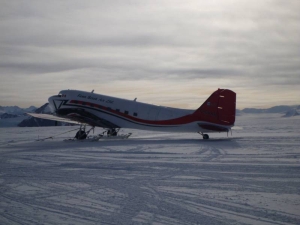Union Glacier“The first night out is never particularly comfortable, but this one was awful.” That was Amundsen’s acerbic comment after the first night in a tent, and we echo the sentiment 100 years later. A sudden shift from a hotel bed to -35°C does not pass unnoticed.
“Gale during the night with thick drift. Eased during the morning. We turned out as usual at 6 o'clock and were ready to start around 8. ”– Amundsen on this day 100 years ago (Read more …) 
ALE is now striving to gather meteorological data about the route from here to the Bay of Whales. We are all on tenterhooks waiting to be informed whether or not we can fly onwards today. We’re ready! Union Glacier is a large base: expeditions pass through here all summer. At present the place is crawling with people who need a lot of time – those who will be going on long ski expeditions. They come from Norway, Australia, and Spain. Later, the adventurers who intend to climb Mount Vinson will arrive, followed by “last degree” skiers (who plan 100-km trips), people who will fly directly to the South Pole on day trips, and tourists who will stay in the immediate vicinity (skiing or mountain climbing), visit a colony of emperor penguins near the coast, or run the annual marathon. The airstrip where our Ilyushin landed on the glacial blue ice is 8 km away. In the camp itself there is a Twin Otter and a Basler (a converted DC-3) fitted with both wheels and skis, which enables it to land on both ice and snow. It is the Basler that will transport us to the Bay of Whales. Apart from that, the base consists of two kitchen tents, a communication centre, storage containers, a field hospital, a mechanical workshop, toilet facilities and a recycling centre. All waste is sorted and shipped back to Chile. In addition there are many tents. Tents are standard accomodations at Union Glacier, even for the people who work here all summer, four whole months. But many of them come back year after year. It becomes a lifestyle. One of the people we encountered is Norway’s preeminent kite-skier, Ronny Finsås, who has the current speed record between the South Pole and the coast. He made it to Hercules Inlet (1130 km) in five days. Did you know that Antarctica is the driest continent on Earth?
The driest, coldest, most sparsely inhabited continent on our planet has plenty of water – but it’s all frozen. |
South Pole 1911–2011 is an informational outreach project run by the Norwegian Polar Institute
Contact person:


